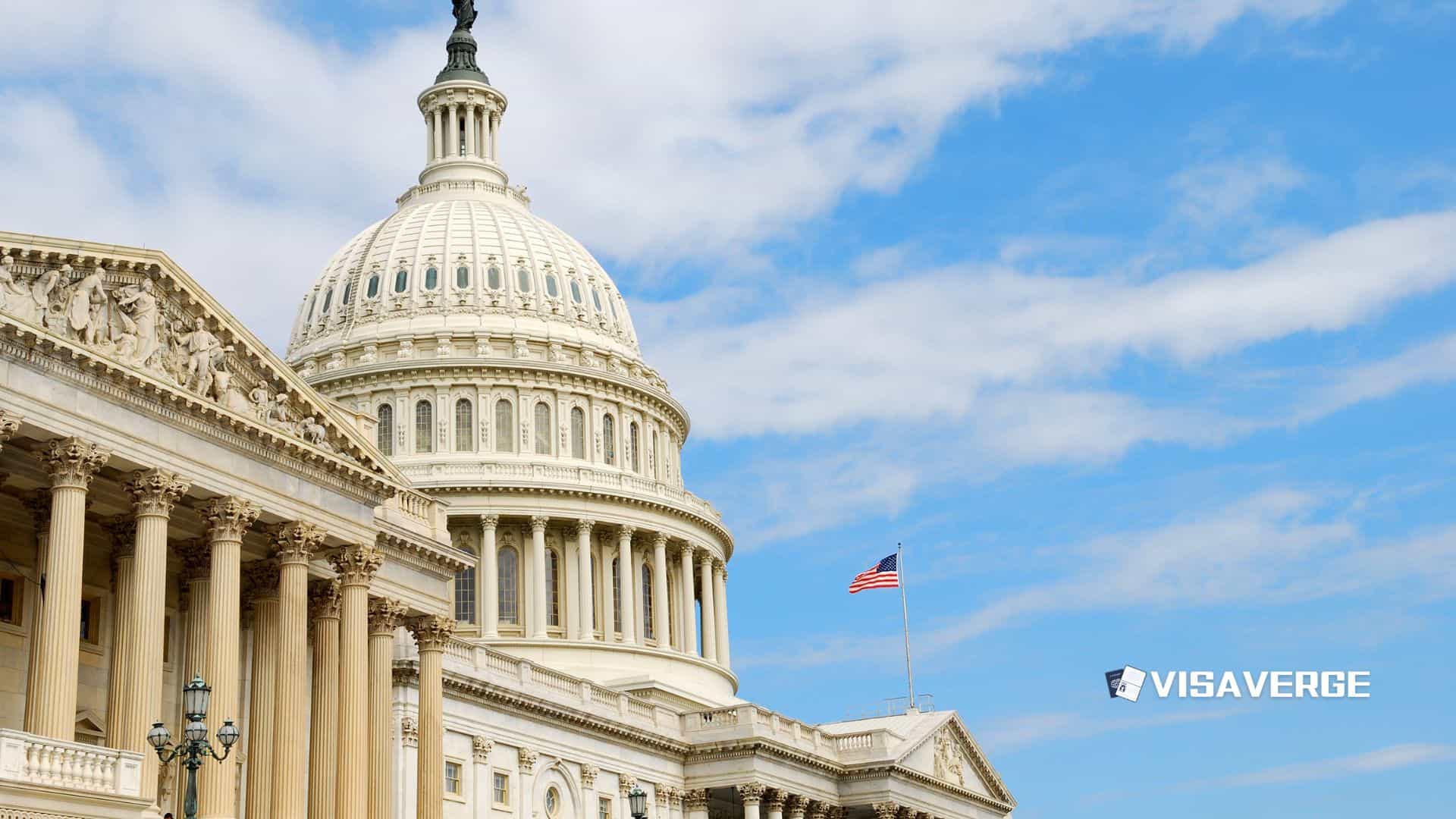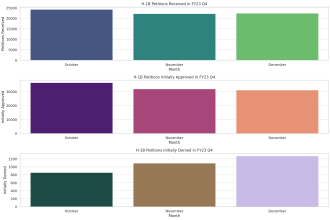Key Takeaways
• House Republicans passed Trump’s $10 billion Border Enforcement Fund on July 3, 2025, boosting DHS border security budget.
• The bill raises mandatory immigration application fees, making legal status harder for low-income immigrants with few waivers.
• No new legalization pathways included; tougher access to public benefits and tax credits for noncitizens remain in effect.
On July 3, 2025, House Republicans passed President Trump’s sweeping tax and spending bill—often called “Trump’s mega bill”—by a narrow 218-214 vote. This nearly 1,000-page package now heads to President Trump’s desk, where he is expected to sign it into law by July 4, 2025. the bill represents a major campaign promise for President Trump and marks a turning point in United States 🇺🇸 immigration policy, with wide-reaching effects for immigrants, their families, and communities across the country.
This article breaks down what’s in the bill, how it affects immigrants, and what comes next. We’ll look at the most important changes, explain technical terms in simple language, and provide practical guidance for those impacted.

What’s in Trump’s Mega Bill?
The bill is best known for its focus on border security and immigration enforcement. It also changes how much immigrants must pay for certain applications and limits access to some government benefits. Here’s a closer look at the main immigration provisions:
Massive Boost for Border Enforcement
One of the most talked-about parts of the bill is the creation of a new $10 billion Border Enforcement Fund. This fund gives the Department of Homeland Security (DHS) a huge amount of money to spend on “safeguarding the borders of the United States 🇺🇸 to protect against the illegal entry of persons or contraband.”
What does this mean in practice?
– The Border Enforcement Fund is almost half the size of the entire Customs and Border Protection (CBP) budget for 2024.
– DHS can use this money for almost any border enforcement activity, with very few limits on how it’s spent.
– This could mean more Border Patrol agents, more technology at the border, more detention centers, and more resources for Immigration and Customs Enforcement (ICE) to find and remove people without legal status.
Higher Fees for Immigration Applications
The bill also introduces mandatory and much higher fees for many immigration applications. This includes:
– Visa applications (for people who want to visit, work, or study in the United States 🇺🇸)
– Green card applications (for permanent residency)
– Applications to change or adjust immigration status
These fee increases are expected to make it much harder for lower-income immigrants to apply for legal status or renew their documents. In many cases, the new fees must be paid up front, and there are very few ways to get a waiver (an exception for people who can’t afford to pay).
Limits on Public Benefits and Tax Credits
Another key part of the bill is its focus on restricting access to public benefits and tax credits for noncitizens. While some of the harshest proposals were removed in the Senate, the final bill still makes it harder for immigrants—especially those without legal status—to get help from the government.
This includes:
– Tighter rules on who can get federal benefits like food assistance or health coverage
– New limits on tax credits for mixed-status families (families where some members are citizens and others are not)
No New Pathways for Legalization
Despite calls from immigrant advocates and some lawmakers, the bill does not create any new way for undocumented immigrants to get legal status. Proposals to help Dreamers (young people brought to the United States 🇺🇸 as children), DACA recipients, or other undocumented groups were removed during the Senate’s review process.
How Will the Bill Affect Immigrants?
The changes in Trump’s mega bill will touch nearly every part of the immigration system. Here’s a step-by-step look at the main impacts:
1. Increased Border and Interior Enforcement
With the new Border Enforcement Fund, DHS will have more money than ever to spend on border security. This will likely lead to:
– More Border Patrol and ICE operations at the border and inside the country
– More checkpoints, surveillance, and technology to detect people crossing without permission
– More arrests, detentions, and deportations of people without legal status
For immigrants—especially those who are undocumented or have pending cases—this means a higher risk of being stopped, detained, or removed from the United States 🇺🇸.
2. Higher Costs for Legal Immigration
The new mandatory fees will make it much more expensive to apply for visas, green cards, or to change immigration status. For example:
– A family applying for green cards may now face thousands of dollars in fees, with little chance of getting a waiver
– Students, workers, and visitors may also see higher costs for renewing or changing their visas
This could force many lower-income immigrants to delay or give up on their applications, making it harder for families to stay together or for individuals to build a future in the United States 🇺🇸.
3. Reduced Access to Benefits and Support
By tightening rules on public benefits and tax credits, the bill will make life harder for many immigrants, especially those in mixed-status families. Some may lose access to:
– Food assistance programs
– Health coverage
– Tax credits that help families with children
This could increase financial hardship and insecurity, especially for families already struggling to make ends meet.
4. No Relief for Dreamers or Undocumented Groups
The bill offers no new protections or pathways to legal status for Dreamers, DACA recipients, or other undocumented immigrants. Existing programs remain unchanged, and there are no new options for people hoping to regularize their status.
Who Supports and Opposes the Bill?
The bill has sparked strong reactions from all sides:
- President Trump: Has promoted the bill as a way to deliver on his campaign promises, especially around border security and immigration enforcement.
- House Republicans: Led the push for the bill, arguing it will make the United States 🇺🇸 “stronger, safer and more prosperous than ever before,” according to House Speaker Mike Johnson.
- Democrats: Voted unanimously against the bill, warning it will hurt vulnerable groups, including immigrants and mixed-status families, and does nothing to help Dreamers.
- Immigrant Advocacy Groups: Say the bill will lead to more family separations, financial hardship, and fear in immigrant communities.
Background: How Did This Happen?
The bill passed through a process called budget reconciliation. This allows the Senate to pass certain budget-related bills with a simple majority, avoiding the usual 60-vote requirement to overcome a filibuster. Because of these rules, only items directly related to federal spending could be included. That’s why proposals for new legalization programs or DACA protections were removed.
The bill continues many of the enforcement-focused policies from President Trump’s first term, doubling down on border security and deterrence rather than integration or legalization.
What Happens Next?
With President Trump expected to sign the bill by July 4, 2025, the new rules and funding will soon take effect. Here’s what to expect:
- DHS and other agencies will quickly start using the new Border Enforcement Fund. This could mean more raids, detentions, and removals in the coming months.
- Immigrants applying for visas, green cards, or other benefits should prepare for higher fees. Check the latest fee schedules on the USCIS official website before submitting any applications.
- Advocacy groups are likely to challenge some parts of the bill in court, especially those that restrict access to benefits or raise due process concerns.
- No new relief is coming for Dreamers or undocumented immigrants. Existing programs like DACA remain unchanged for now.
Practical Guidance for Immigrants and Families
If you or your family are affected by these changes, here are some steps you can take:
- Check your eligibility and prepare for higher fees. Before applying for any immigration benefit, review the latest requirements and costs. The USCIS Forms page has up-to-date information and official forms.
- Stay informed about enforcement actions. If you are undocumented or have a pending case, know your rights and have a plan in case of an encounter with immigration authorities. Many community organizations offer free resources and legal clinics.
- Review your eligibility for public benefits. If you receive federal benefits or tax credits, check with your local agency or a trusted legal advisor to see if the new rules affect you.
- Seek legal advice if you are unsure. Immigration law is complex, and the new changes make it even more important to get accurate information. Look for help from licensed immigration attorneys or accredited representatives.
Key Takeaways for Stakeholders
- Immigrants and Families: Face higher costs, more enforcement, and fewer benefits. No new options for legalization.
- Employers: May see changes in the availability of immigrant workers, especially if higher fees and enforcement deter legal immigration.
- Advocacy Groups: Will likely focus on legal challenges and supporting affected communities.
- Lawmakers: The bill’s passage shows the power of the reconciliation process and the deep divide between parties on immigration.
Official Resources
For the most reliable and current information, use these official sources:
– U.S. Citizenship and Immigration Services (USCIS) – for forms, fee schedules, and application instructions
– Department of Homeland Security (DHS) – for enforcement updates and policy guidance
– American Immigration Council – for analysis and fact sheets on immigration policy
Looking Ahead: What’s Next for Immigration Policy?
The passage of Trump’s mega bill marks a major shift toward stricter enforcement and higher barriers for immigrants. With Democrats united in opposition, any future changes—such as new legalization programs or relief for Dreamers—will depend on the outcome of future elections.
In the meantime, DHS and related agencies are expected to move quickly to use the new Border Enforcement Fund, which could lead to more enforcement actions and increased fear in immigrant communities. Legal challenges are likely, but the immediate impact will be felt by those facing higher fees, reduced benefits, and greater risk of detention or deportation.
As reported by VisaVerge.com, the bill’s focus on enforcement over integration or legalization is a clear signal of the current administration’s priorities. Immigrants, families, and advocates should stay alert, seek trusted information, and prepare for a more challenging environment in the months ahead.
Conclusion
Trump’s mega bill, passed by House Republicans and soon to be signed into law, brings sweeping changes to United States 🇺🇸 immigration policy. With a $10 billion Border Enforcement Fund, higher application fees, and tighter benefit rules, the bill will reshape the lives of millions of immigrants and their families. While supporters say it will make the country safer, critics warn of increased hardship and fear. The coming months will reveal the full impact, but one thing is clear: the landscape for immigrants in the United States 🇺🇸 has changed, and staying informed is more important than ever.
Learn Today
Border Enforcement Fund → A $10 billion fund for DHS to enhance border security and immigration enforcement activities with minimal restrictions.
Reconciliation process → A Senate procedure allowing budget-related bills to pass with a simple majority, avoiding a 60-vote filibuster.
DACA → Deferred Action for Childhood Arrivals, a program protecting young undocumented immigrants from deportation.
USCIS → U.S. Citizenship and Immigration Services, the agency processing immigration applications, visas, and status adjustments.
Mixed-status families → Families with members having different immigration statuses, often affecting eligibility for benefits and tax credits.
This Article in a Nutshell
Trump’s mega bill passed July 3, 2025, increases border enforcement with $10 billion funding, raises immigration fees significantly, and restricts public benefits access, but offers no legalization pathways. Immigrants face higher costs, increased deportation risks, and fewer supports, marking a major shift in U.S. immigration policy under this new law.
— By VisaVerge.com













